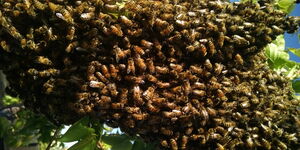Former Deputy President Rigathi Gachagua has claimed he narrowly escaped an alleged state-sponsored scheme to assassinate him using biological agents.
According to Gachagua, a squad that had reportedly been sent to attack him consisted of experts in biological weapons, and they were to poison him through inhaled chemicals that would paralyse his brain over three months.
Kenyans.co.ke has since learnt that poisoning through aerosolised or inhaled chemicals is not as rare and ranges from regular pesticides to heavy metals and highly lethal toxins specifically designed to be used as biological weapons.
In this article, we will explore several toxins, most of which have the potential to attack the nervous system, leaving victims incapacitated.
Mercury Vapour
Although the most recorded cases of mercury vapour poisoning are through occupational hazards, the potency of the heavy metal makes it a popular candidate as a biological weapon.
Once inhaled, the vapour is rapidly absorbed into the bloodstream and crosses the blood-brain barrier, thereby oxidising to mercuric ions, which lead to neuronal damage.
Some of its acute symptoms include cough, chest pain, dyspnoea, nausea, vomiting, and fever, with severe exposure leading to Acute Respiratory Distress Syndrome (ARDS), chemical pneumonitis, and even death.
Long-term exposure could lead to neurological symptoms like tremors, insomnia, memory loss, and cognitive dysfunction.
However, if used for poisoning, it can be detected by medical personnel through a toxicity test.
Sarin
This is one of the most documented agents that have been used to carry out bioterrorism attacks across the globe. Highly potent, it is classified as a Schedule 1 substance under the Chemical Weapons Convention (CWC), which means it has no other significant uses other than as a chemical weapon.
Designed to instantly kill, it can also be used to slowly kill by being administered in small doses over a prolonged period to slowly inhibit their muscle functions.
It is a colourless, odourless and tasteless liquid, making it easy to conceal and ultimately more deadly.
Long-term effects include chronic neurological symptoms, respiratory issues and psychological effects such as anxiety and depression.
Botulinum toxin
This is one of the most lethal toxins known to man, which, when ingested, attacks the body's nerves, leading to paralysis. Caused by the bacterium Clostridium botulinum, botulism can be administered both through food and inhalation, as well as other means.
According to the World Health Organisation (WHO), inhalation botulism is not naturally occurring and is only associated with lab accidents or intentional events like bioterrorism. It is highly potent, with only two nanograms of the toxin per kilogram of body weight considered lethal.
Its implications include respiratory paralysis, muscle weakness, and difficulty speaking, swallowing, or moving by blocking nerve signals. The earliest symptoms, which typically set in within one to three days, are fatigue, blurred vision, and dry mouth.
Astonishingly, this is the same toxin used in the cosmetic procedure Botox. However, these treatments employ the purified and heavily diluted botulinum neurotoxin type A.
Mycotoxins
These are toxic secondary metabolites produced by certain fungi like Aspergillus, Fusarium, and Stachybotrys species that can be used as biological weapons.
Although the implications of its poisoning could be lethal, aerosolisation of mycotoxins requires specialised equipment and may be less effective in open environments.
They can be difficult to diagnose, complicating the detection and attribution of attacks and also slowing down physicians trying to save a victim of the poisoning.
Cyanide
Cyanide is another highly potent chemical that exists in various forms, including gas and is often used in carrying out executions.
When ingested, it inhibits cytochrome c oxidase, an enzyme in the mitochondrial electron transport chain, preventing cellular respiration. This means that cells cannot use oxygen, a condition called histotoxic hypoxia.
This phenomenon makes it one of the deadliest chemical weapons, as organs which need oxygen the most, including the brain and the heart, start collapsing fast.
Death can occur in mere minutes of exposure.
In most of these situations, however, antidotes are available, and it all depends on how long one was exposed, how fast they sought treatment and how much they were exposed to.
Bioterrorism or biological warfare, has long been used in high-profile assassinations since time immemorial and will probably continue. In Kenya, none of these have been recorded except allegations made by the former deputy president.












